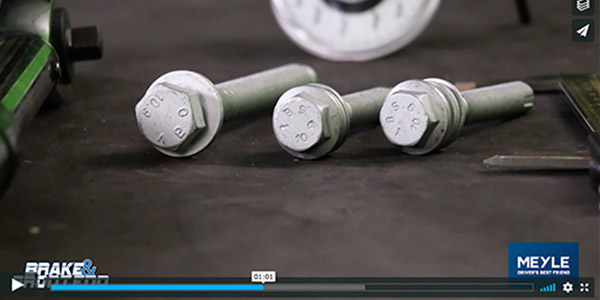In this Tech Minute, Andrew Markel covers everything about TTY bolts and how their build could affect your next suspension repair.
Brought to you by MEYLE.
Video courtesy Brake & Front End.
Additional information from Andrew Markel:
What do some ball joints, tie rods and suspension components have in common with engines? The answer is torque-to-yield (TTY) fasteners. These bolts and studs that stretch are becoming more common on vehicles — not just under the hood, but under the car. TTY fasteners are mounting fasteners which are torqued beyond the state of elasticity, and therefore, undergo plastic transformation that causes them to become permanently elongated.
Some ball joints, and almost all tie-rod ends, use a tapered stud and hole with a nut on top to secure the stud to the knuckle. The 7-10º angled taper, along with a threaded stud and nut, lock the components together by tensioning the nut and stud. TTY ball joint and tie-rod studs have two advantages. First, they can weigh less and still apply the same clamping loads. Second, the clamping loads are more consistent and controllable.
Installation
TTY ball joints and tie rods are usually installed dry. Do not apply any oil, grease, assembly lube or sealer on the stud or tapered bore. The reason why is that lubricants reduce friction when a bolt is tightened. This actually increases the torque load on the bolt or stud, which may overload and stretch a TTY bolt too far, causing it to break.
The increased torque can also cause the female part of the taper to crack as too much clamping force is applied.
Aluminum knuckles, upper control arms and ball joints can be damaged if not tightened using the correct procedure. Knuckles and upper control arms are aluminum and can be damaged if a torque wrench and torque angle gauge are not used. No matter if you go too tight or too loose, if you fail to use correct tools and procedures, you could be buying the customer a knuckle.
Many ball joints may have an initial torque spec as low as 15-30 ft/lbs, and torque angles are between 140º and 225º.
Reusing TTY Items
Make sure you check the service information to see if a TTY ball joint or tie-rod end is reusable after it has been removed. Some manufacturers recommend that a joint be replaced, while others do not indicate if it should.
For the technician trying to avoid dealing with this conundrum, it may be better to remove the control arm with the knuckle or separating tie rods between the inner and outer shaft. It is easier and less expensive to sell an alignment rather than face the possibility of a ball joint replacement in some cases.
Identifying TTY Ball Joints and Tie Rods
The metallurgy and heat treatment of TTY bolts and regular bolts is different, and you can sometimes tell one from the other by their appearance. Always make sure to check the service information to get the right torque for a suspension component regardless of the type of fastener. If you see an initial torque spec along with an angle in degrees, it is a TTY fastener.














